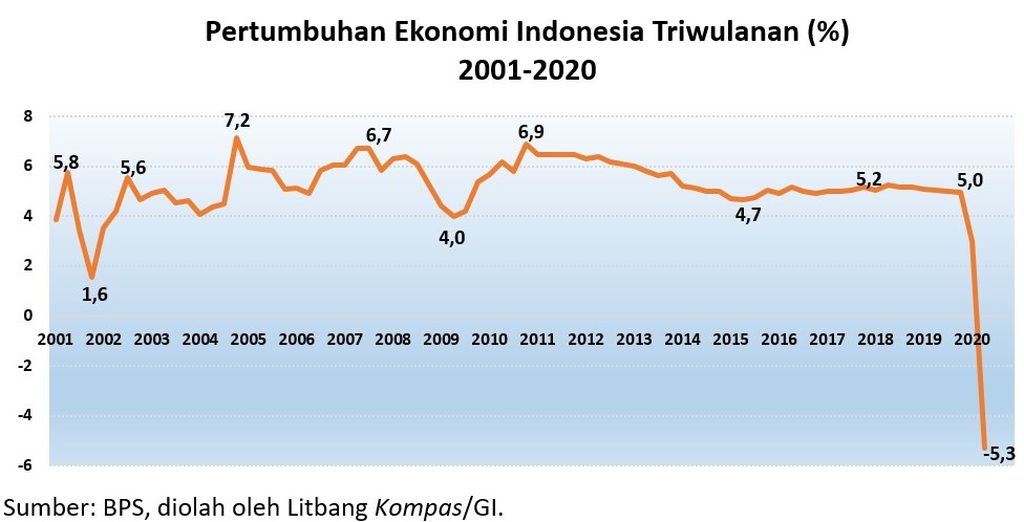The Road to Recovery
There are two ways to measure quarterly growth based on the initial position. First, by comparing with the last year and second, by comparing with last quarter.
/https%3A%2F%2Fkompas.id%2Fwp-content%2Fuploads%2F2019%2F11%2FAri-Kuncoro_75152262_1572887656.jpg)
Ari Kuncoro
There are two ways to measure quarterly growth based on the initial position. First, by comparing with the last year and second, by comparing with last quarter.
The condition of the world before the Covid-19 pandemic (2019) and during the pandemic (2020) is quite different. Measurements using the method on an annual basis show how far Indonesia came out from its natural growth path before the pandemic. As for the method on a quarterly basis, it measures if there is a continuous improvement towards a natural growth pathway.
Growth trajectory
Statistics Indonesia (BPS) announced that Indonesia\'s annual economic growth in the third quarter of 2020 was recorded at minus 3.49 percent, better than minus 5.32 percent in the second quarter of 2020. The contraction was deeper than the lower limit predicted by the World Bank (minus 2 percent) and the Indonesian government (minus 2.9 percent). This figure is not too surprising. Several indicators have shown a weakening as a consequence of the large-scale social restrictions (PSBB) in Jakarta.
The impact on the real sector was a decline in the Purchasing Managers\' Index (PMI), which fell to 47.2 in September and only edged up to 47.8 in October. In fact, in August, the figure rose to 50.8, which showed that there was an expansion.
Also read: Pandemic-Induced Trade Surplus
This is consistent with the Consumer Confidence Index (CCI) published by Bank Indonesia. The CCI fell to 83.5 in September from 86.9 in August. The decline occurred in all expenditure components. Consumer confidence in buying durable goods weakened, especially in the group of people with income above Rp 5 million.
It was seen in the growth in annual consumption in the third quarter of 2020, which was initially expected to be better but instead fell 4.04 percent or slightly better than that in quarter II-2020 which declined by 5.52 percent.
Also read: The Burden of National Debts
As usual, indicators in the financial sector move ahead of those in the real sector if there is a change in expectations (Dornbusch [1996]). The share price rose when the Jakarta administration announced its decision to extend the PSBB social restrictions on 12 Oct. At the beginning of the week on Monday (12/10/2020), the Jakarta Composite Index (JCI) of the Indonesia Stock Exchange rose 0.48 percent to 5,078.12 at the opening of trading.

Indonesia Economic Quarterly Growth. Source: BPS
Foreign investors booked a net buy of Rp 11 billion in the regular market, which recorded a daily transaction value of Rp 1 trillion. What happened then, the rupiah also strengthened. The combination of a trade balance surplus, the approval of the Job Creation Law, and better handling of the Covid-19 pandemic has attracted the flows of portfolio investment to Indonesia.
According to data issued by the Covid-19 Task Force, at the end of October, the recovery rate in the country was 81.6 percent, higher than the world average of 73.12 percent. Meanwhile, the number of active cases was 14.9 percent (of total confirmed cases), lower than the world average of 24.23 percent. However, the death rate, which reached 3.4 percent was higher than the world average of 2.63 percent.
Also read: Analyzing Recession
The handling of the pandemic has become a dashboard for the movement of international portfolio investment. Indonesia is an attractive alternative, especially with the prospect of a second regional quarantine in Europe due to the second wave of Covid-19.
Employment indicators
The World Health Organization (WHO) has praised Indonesia’s success in controlling Covid-19. However, the central and local governments must remain vigilant about the possibility of a further increase in new cases, especially after the recent long holiday.
The reason is that the movement of variables in the real sector is determined by the perception of health, especially the upper middle class. The upper middle class preferred to keep their money in banks, affecting their purchasing power. In August, third party funds (DPK) in the form of deposits of more than Rp 2 billion (56 percent of total DPK) grew 14.1 percent.
Also read: Signs of Recession Get Stronger
The upper middle class will increase spending in line with the improvement of the health indicators. This will increase the leverage of the government\'s stimulus so that the economy will grow faster and in return it will be able to create job opportunities.

Visitors choose clothing products at discounted prices at a shopping center in the South Jakarta area, Sunday (11/8/2020). Shopping centers have begun to be visited by many residents on weekend holidays. Apart from trying to overcome the health crisis caused by the Covid-19 pandemic, the government is also trying to get out of the recession zone.
Meanwhile, the labor indicator shows more of the spending behavior of the lower middle class. BPS announced that as of last August, 29.12 million people of working age, or 14.29 percent of the total, were affected by the Covid-19 pandemic. The number was large enough to change consumption behavior. As the concerns of layoffs grow, people prefer to save every rupiah they receive. This behavior slows down the economy.
Like other people who avoid risk, they cannot be blamed as increased uncertainty will add to caution. This can be seen from the growth of the deposits of below Rp 100 million (14 percent of total DPK) from 4 percent in July to 6.3 percent in August.
Taking advantage of momentum
The economic growth and employment data only reflected the condition until August 2020 before there were improvements in health indicators in the handling of Covid-19. Although there are fears of a significant increase in new cases, the momentum of economic recovery can be seen from the enthusiasm of residents to travel on the long holiday recently.
Quarterly gross domestic product (GDP) growth data show the distance to return to a positive growth trajectory. The Indonesian economy grew 5.05 percent quarter-on-quarter (qoq) in the third quarter. It meant there was an improvement. However, the cumulative quarterly growth that was already underway was still recorded at minus 2.03 percent. This figure illustrates how hard the effort is to get back into the positive growth zone.
Without reducing awareness, the turning point in handling the pandemic, which has moved to a better direction since the end of October, can be an asset to improve health perception in the fourth quarter of 2020. Furthermore, it can be the take-off stage of the economic recovery in 2021.
ARI KUNCORO, Rector of the University of Indonesia.